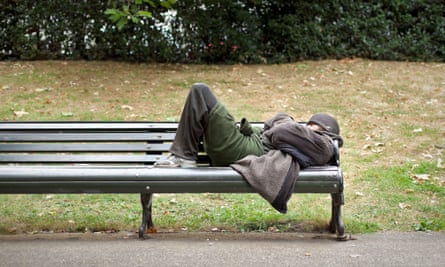Rough sleeping in England has increased for the seventh consecutive year, official figures show, and charities say even this steep rise fails to capture the true level of street homelessness.
Statistics published by the government on Thursday reveal that an estimated 4,751 people bedded down outside overnight in 2017, up 15% on the previous year.
The figures – based on single-night snapshot street counts or paper estimates by local authorities – show that London, where figures rose by 18%, remains the centre of rough sleeping, accounting for nearly a quarter of all rough sleepers.
The rest of England recorded a 14% rise, with the biggest regional increase in the north-west (39%), where rough sleeping has almost doubled over the past two years and quadrupled since 2010. Hotspots included Tameside, Salford and Manchester.
The statistics also show the continued spread of rough sleeping into areas of the south. Oxford, Southend-on-Sea, Thanet, Swindon, Medway, Eastbourne, Hastings, Worthing, Peterborough, Reading and Wiltshire all recorded rises of at least double the national average.
Homelessness charities said the figures, up 169% since 2010, were a catastrophe and a scandal, while Labour blamed government policies for what it called the “shameful” figures and promised to eliminate rough sleeping in the first term of a Labour administration.
Balbir Chatrik, director of policy at the Centrepoint charity, said: “These figures are shocking, but they only attempt to count the number of people sleeping rough on one night. We know there are thousands more young people who are hidden homeless – sofa-surfing for months on end, sleeping on public transport or staying with strangers just to find a bed for the night.”
The government has pledged to halve rough sleeping by 2022 and eradicate it completely by 2027. It is investing £28m in trials of a Finnish-style “housing first” approach to support rough sleepers with complex needs in Manchester, Liverpool and the West Midlands, and it is introducing a homelessness reduction bill in April.
A spokesman for the Ministry of Housing, Communities and Local Government said: “In addition, a new cross-government taskforce supported by a panel of experts will drive forward a new strategy that will make life on the streets a thing of the past.”
John Healey, the shadow housing secretary, said: “This is a direct result of decisions made by Conservative ministers: a steep drop in investment for affordable homes, crude cuts to housing benefit, reduced funding for homelessness services and a refusal to help private renters.
“A Labour government will end rough sleeping within its first term in office and tackle the root causes of rising homelessness.”
Howard Sinclair, chief executive of the homeless charity St Mungo’s, said: “Another huge rise in the number of men and women sleeping rough in England, for seven years in a row and 169% since 2010, is shocking and a scandal. While the manifesto commitment from the government on rough sleeping and the initial steps taken to achieve the target is welcome, the latest figures serve as a stark reminder of the need for urgency.”
Jon Sparkes, the chief executive of Crisis, said: “It is truly a catastrophe that in a country as prosperous as this, more and more people are finding themselves forced to sleep in dangerous and freezing conditions when we have evidence to show how the situation could be turned around.”
Polly Neate, the chief executive of Shelter, said: “These figures expose the worst pain inflicted by our housing crisis. We have failed as a society when so many people are forced to sleep rough.”
The London borough of Camden posted a 647% increase to 127 rough sleepers, appearing to correct a huge underestimate the previous year when just 17 were recorded. The council said this reflected a change from paper estimates to an actual street count, together with an increase in Romanian rough sleepers.
When population size is taken into account, the statistics show that 92 local authorities had rough sleeping rates that were worse than the national picture. Thirty-two authorities, including Barking and Dagenham and Barnsley, claimed to have had zero rough sleepers.

Paul Dennett, the mayor of Salford and the Greater Manchester Combined Authority’s lead for housing, planning and homelessness, said: “The current epidemic of homelessness and rough sleeping across Britain has been created by a precarious labour market and vicious cuts to benefits payments in the middle of an economic crisis – when people are already struggling to make ends meet.”
Rough sleepers are defined for the purposes of official counts as people sleeping, about to bed down or bedded down on the street, in doorways, parks, tents, bus shelters, cars, barns, sheds and other places not designed for habitation. It does not include people in hostels or shelters.
It is widely acknowledged that the statistics are not an accurate picture of the numbers of people rough sleeping, though they do reflect general trends. The separate Chain database, which records rough sleepers in London seen by outreach workers, last June reported 8,108 rough sleepers.
The government is currently reviewing the way it collects homelessness statistics after a critical report two years ago by the UK statistics authority, which said its rough sleeper figures were untrustworthy and vulnerable to political manipulation.
